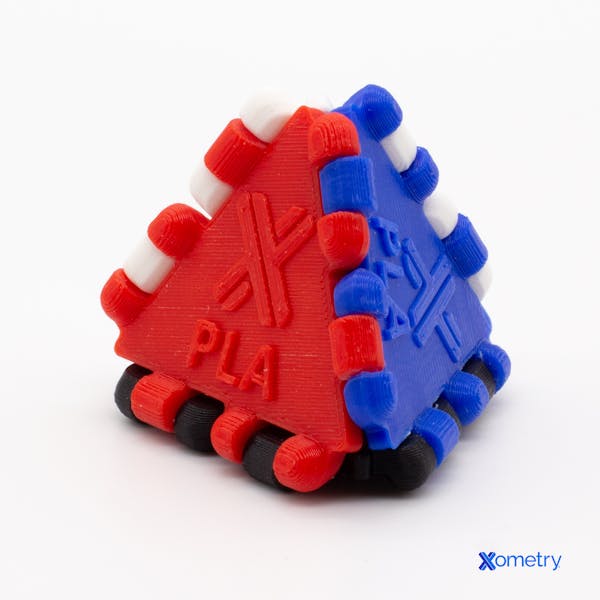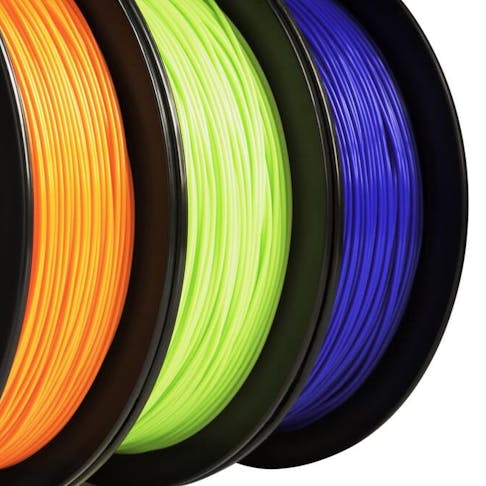When deciding between PLA (polylactic acid) and PLA+ filaments, it can be difficult for you to discern which one is best for your project. While the two materials have many similarities, they also have three notable differences—mechanical properties, ease of printing, and cost.
PLA is the most commonly used filament in fused deposition modeling (FDM) 3D printers. It’s affordable, readily available, and easy to print. However, it lacks the mechanical strength for use under load-bearing conditions compared to PLA+. PLA+ is an augmented version of PLA. PLA+ contains additives and modifiers that make it stronger and tougher, with better layer-to-layer adhesion than conventional PLA. While those additives make for a more useful material, they also make PLA+ more expensive.
This article will dive deeper into the differences between PLA and PLA+, and present you with comparisons of the two materials to help you understand which material is best for your project.
PLA Definition and Comparison to PLA+
PLA is one of the most commonly used thermoplastics. Unlike other thermoplastics, typically petroleum-based, PLA is made from lactic monomers extracted from natural crops like corn or sugarcane. Polylactic acid was first synthesized through polycondensation in 1845 by Théophile-Jules Pelouze. In 1932, Wallace Hume Carothers and his team synthesized PLA into a polymer material. Dupont later patented this process in 1954.
Since it’s derived from natural sources, PLA is eco-friendly and biodegradable. It has characteristics similar to polypropylene (PP) or polyethylene (PE). PLA can be used in 3D printers, injection molding machines, and extruders. PLA is preferred over PLA+ for general-purpose 3D printing because it’s easy to print, doesn’t require a heated build platform, and is highly affordable. To learn more, see our article on What is PLA.
The parts in the image below were 3D printed by Xometry using our online 3D printing service in various colors of PLA:

What are the Advantages of PLA Compared to PLA+?
Listed below are some advantages of PLA vs. PLA+:
- It is inexpensive and readily available since PLA is the most commonly used filament for 3D printing.
- PLA is an environmentally-friendly “bioplastic,” since it is derived from cornstarch and sugarcane.
- It is easy to print due to the low temperatures needed to extrude PLA, which eliminates the need for a heated build platform.
What are the Disadvantages of PLA Compared to PLA+?
Listed below are the disadvantages of PLA vs. PLA+:
- Its low impact strength makes PLA-printed parts unsuitable for parts requiring high mechanical strength for load-bearing.
- The slower crystallization rate of PLA can lead to poor dimensional control. This is due to PLA’s short monomer length.
- PLA’s low melting point and poor thermal stability, make PLA-printed parts unsuitable for high-temperature applications.
- PLA has a relatively high permeability to both liquids and gasses, making it unsuitable for containment purposes.
PLA+ Definition and Comparison to PLA
PLA+ is derived from standard PLA, made by the addition of modifiers during PLA synthesis. Several types of PLA+ are produced by various companies. The exact formulation by which manufacturers make their versions of PLA+ are trade secrets. Therefore, there is no one specific PLA+ composition.
PLA+ eliminates some of the negative characteristics of standard PLA. It has improved strength, ductility, and flexibility compared to PLA. This makes PLA+ great for parts requiring mechanical strength in load-bearing applications. PLA+ can tolerate higher temperatures than standard PLA. This characteristic makes it possible to use PLA+ in hotter service environments. PLA+ printed parts also tend to have a smoother surface and better cosmetic appearance than standard PLA-printed parts because the surface is less porous and less rough.
What are the Advantages of PLA+ Compared to PLA?
Listed below are the advantages of PLA+ vs. PLA:
- Improved mechanical properties (flexibility, strength, ductility, etc.) make PLA+-printed parts suitable for functional use.
- Increased heat resistance makes PLA+-printed parts useful in high-temperature applications.
- Better print quality leads to PLA+-printed parts being more dimensionally accurate and aesthetically pleasing.
- Reduced creep and increased strength in cantilevered components with PLA+ due to increased heat resistance.
What are the Disadvantages of PLA+ Compared to PLA?
Listed below are the disadvantages of PLA+ vs. PLA:
- PLA+ is more expensive than standard PLA since PLA+ contains additives to improve its mechanical properties.
- PLA+ is more difficult to print than standard PLA because it requires higher extrusion temperatures to print parts.
| Attribute | PLA | PLA+ |
|---|---|---|
Attribute High-resolution | PLA No | PLA+ Yes |
Attribute Dimensional accuracy | PLA +0.05 mm | PLA+ +0.03 mm |
Attribute Easy setup for printing | PLA Yes | PLA+ Yes |
Attribute Use for proof-of-concept | PLA Yes | PLA+ Yes |
Attribute Use for parts required in load-bearing applications | PLA No | PLA+ Yes |
Attribute Use in high-temperature environments | PLA No | PLA+ Yes |
Attribute Environmentally friendly “bioplastic” | PLA Yes | PLA+ No |
Attribute Cost | PLA $15 to 20 per kg | PLA+ $25 to 35 per kg |
Though PLA and PLA+ have many similarities, they differ in mechanical performance and friendliness to the environment since PLA is made from starch and sugar while PLA+ has additives. PLA is brittle and weak. PLA+ is stronger, more flexible, and more ductile. The use of additional fillers/additives makes PLA+ have greater heat resistance than standard PLA. PLA+ materials are used in high-temperature environments—so long as the temperature doesn’t exceed its glass-transition temperature of 130 °F.
PLA vs. PLA+: Applications Comparison
Both PLA and PLA+ are commonly used in: non-dyed food packaging (mostly for short shelf-life products); medical products (such as implants) due to their biocompatibility; and textiles. However, PLA+ can also be used in automotive applications, for interior trim, door panels, and floor mats. PLA is great for low load-bearing applications and moderate temperature environments. PLA+ can be used in similar applications where higher strength and flexibility, or greater heat resistance is desired.
PLA vs. PLA+: Part Accuracy Comparison
PLA-printed parts tend to have lower dimensional accuracy compared to PLA+. When parts are printed via an FDM printer, they shrink as they cool. On average, standard PLA has a dimensional accuracy of +0.05 mm, while PLA+ filaments have dimensional accuracy of around +0.03 mm.
PLA vs. PLA+: Speed Comparison
Standard PLA parts can be printed faster than PLA+ parts. Average print speeds using standard PLA filaments are around 40-100 mm/s, while print speeds for PLA+ average 40-80 mm/s.
PLA vs. PLA+: Surface Comparison
PLA-printed parts have a relatively rough surface texture due to the extrusion process used for printing. Smooth, shiny surfaces can only be achieved on PLA parts with post-processing. PLA+ printed parts tend to have smoother, glossier surfaces as-printed.
PLA vs. PLA+: Heat Resistance Comparison
Most PLA+ formulations have better heat resistance than PLA. This is because PLA+ usually contains additives that allow it to maintain its mechanical properties to higher temperatures than standard PLA. However, not every PLA+ material will have better heat resistance than PLA. Some PLA+ materials have equivalent heat resistance to standard PLA.
PLA vs. PLA+: Biodegradability Comparison
PLA has a higher degree of biodegradability than PLA+ because PLA is derived from plant materials like cornstarch and sugarcane. PLA+ is also biodegradable to a certain extent. However, because of the additives used to make PLA+, it may not be as environmentally friendly as standard PLA. It is recommended to check the material data sheet of the PLA+ grade you’d like to purchase if biodegradability is an important consideration.
PLA vs. PLA+: Toxicity Comparison
Though PLA+ contains additives not used in standard PLA, PLA+ is not toxic. This is because the additives used in PLA+ are non-toxic elastomers such as TPU (thermoplastic polyurethane). Toxicity levels are then approximately the same between PLA and PLA+.
PLA vs. PLA+: Cost Comparison
PLA+ tends to be more expensive than standard PLA due to the addition of special-purpose modifiers in PLA+. Standard PLA costs about $15 to 20 per kg of filament. PLA+, on the other hand, starts at $25 per kg and can be as much as $35 per kg.
Common FAQs About PLA vs. PLA+
What are the Mutual Alternatives to PLA and PLA+?
Mutual alternatives to both PLA and PLA+ includes:
- PETG (polyethylene terephthalate glycol)
- ABS (acrylonitrile butadiene styrene)
PETG and ABS are plastics that are often used in FDM printers. Their material properties are similar to those of PLA and PLA+. Both PETG and ABS have about the same mechanical strength as PLA+. Additionally, they are relatively easy to print and can be used for functional parts.
What are the Similarities Between PLA and PLA+?
Similarities between PLA and PLA+ include:
- Both are easy to print compared to other FDM filament types.
- Both are great for proof-of-concept prototypes.
- Both are relatively cheap compared to other FDM filaments.
- Both exhibit minimal shrinkage after printing compared to other filaments.
What are the Other Comparisons for PLA Besides PLA+?
Listed below is another comparison for PLA besides PLA+:
- PLA vs. PE: PE is an alternative to PLA which has comparable thermal and mechanical properties. However, PE is a bit stronger and more flexible. Like PLA, PE can be used for food packaging as long as there are no harmful additives present. Additionally, both materials are inexpensive compared to other filaments.
What are the Other Comparisons for PLA+ Besides PLA?
Listed below is another comparison for PLA+ besides PLA:
- PLA+ vs. Nylon: Nylon is an alternative to PLA+ which has similar mechanical properties. Like PLA+, nylon is durable, flexible, and resistant to high temperatures. Additionally, it can be used for functional prototypes similarly to PLA+.
Summary
Xometry provides a wide range of manufacturing capabilities including CNC machining, 3D printing, injection molding, laser cutting, and sheet metal fabrication. Get your instant quote today
Disclaimer
The content appearing on this webpage is for informational purposes only. Xometry makes no representation or warranty of any kind, be it expressed or implied, as to the accuracy, completeness, or validity of the information. Any performance parameters, geometric tolerances, specific design features, quality and types of materials, or processes should not be inferred to represent what will be delivered by third-party suppliers or manufacturers through Xometry’s network. Buyers seeking quotes for parts are responsible for defining the specific requirements for those parts. Please refer to our terms and conditions for more information.

